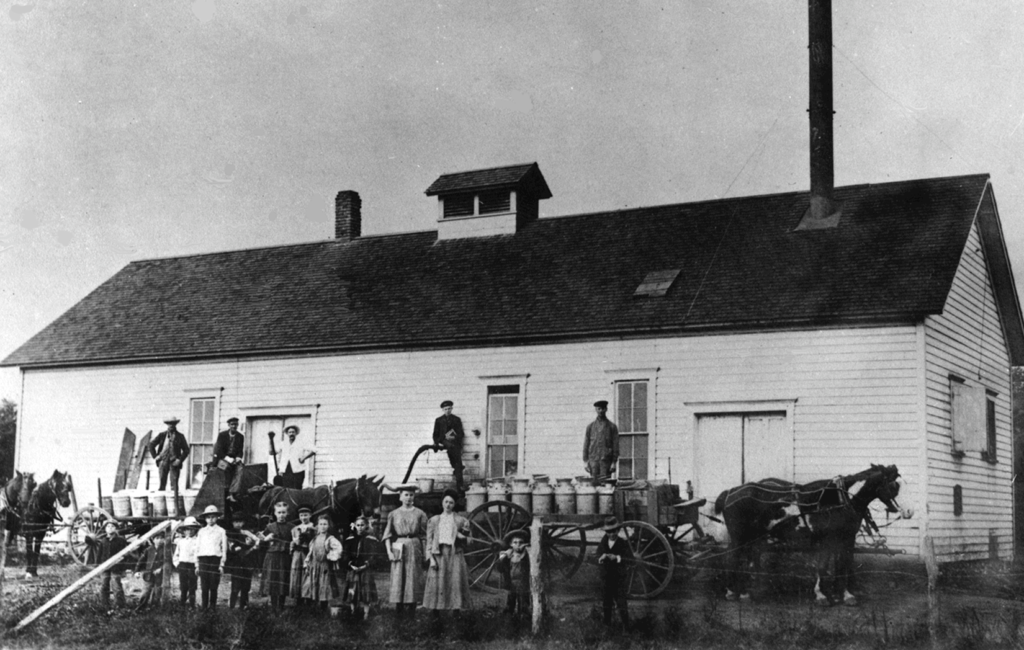
SRHS
Steamboat Rock Historical Society
A NEW CENTURY
THE CREAMERY
Steamboat Rock’s first creamery had been started by Thomas Neessen during the 1870’s and continued in business into the 1880’s when it closed seemingly for good.
On April 13, 1901, the Steamboat Rock Creamery Company was organized. Capital in the amount of $4,000 was raised through the sale of stock at $100 per share. Nearly every area farmer bought stock.
The officers and first board of directors of the company were D.W. Turner, President; Otto Wilts, Vice-President; Elda Christians, Secretary, and H.A. Eckhoff, George F. Henrichs, Antone Luiken, H. Santen and S. P. Johnson. Directors. Louis A. Luiken Jacob Cramer.

The following is the list of names of the original stockholders, S.P. Johnston, Otto Wilts, Antone Luiken, George Henrichs, D. W. Turner, H. A. Eckhoff, E. Christians, F. H. Stern, H. Santen, Heme Ruter, H.H. Turner, T.E. Gearhart, D. DeVries, John Wilts, H. Johnson, Albert E. Schmidt, J. B. Janssen, H.J.. Bakker, Robert McGraw, George Haynes, C. H Smith, Carl W. Schmidt, Henry Jackson, F. L. Willis, Eilers Hardware Co., C. E. Greef, Mrs. A.B.Jaspers, H. J. Finster, Ferdinand Schuneman, M.F. Finster, Carl Hass, T. Hartman, Henry Wubben, C.F. Schmidt, Dick Christians, E. Karsjens, John J. Meints, Jake Okken, George Folkerts, Coert Wubben.
A building was erected on the east bank of the river, east of the bridge on the south side of the road.
This is presumed to be the first business established in Steamboat Rock, on a cooperative basis. The company bought whole milk from farmers in the surrounding area which was hauled into town with wagons and teams, usually by milk haulers who had an established route which was covered daily except Sunday.
Before the creamery, women would put milk into large flat pans and set them aside in a cool place to allow the cream to rise to the top. When the cream was on top, she would skim it off and save it to churn into butter.
A farmer had to not only milk his cows by hand, but had to water them by hand as well. A chore that, in dry weather, meant hauling up endless buckets of water that had to be pumped by hand. He had to feed his livestock by hand, pitch forking heavy loads of hay up into the loft of his barn and then stomping on it to soften it enough so the cows could eat it. He had to prepare the feed by hand: he would get the corn kernels for his mules and horses by sticking ear after ear of corn, hundreds of ears of corn, one by one into a corn sheller and cranking for hours.
Because there was never enough daylight for all the jobs that had to be done, the farmers usually finished after sunset, ending the day as he had begun it, stumbling around the barn milking the cows in the dark. He had to milk his cows by hand – arising at three-thirty or four o’clock in the morning to do so, because milking was such a time consuming job (over two hours just for 20 cows) and it had to be done by daylight. Every hour of daylight was needed for work in the fields. The whole morning milking process had to be repeated again at night. Milking was done by dim kerosene lanterns, or in the dark. Many farmers were afraid to use lanterns in the barn, because even a spark, could burn down a hay-filled barn.
It was difficult, at best, to keep their milk cold before it was sold. Milk had to be kept on ice, which was expensive, and farmers had to lug it from town. Sometimes milk was kept in a pit, or water tank to try to keep it cool until it was taken to town, or in later years picked up by the creamery.
At the creamery the milk was separated and the skimmed milk was sent back to the farms, while the cream was churned and the butter was sold locally the remaining was packed for shipment to distant markets by railroad.
The creamery had its ups and downs and had a number of changes in management. There were even times when it shut down altogether due to financial difficulties. One of these occurred in 1910, and it remained closed for over a year before it resumed operation when in February 1911 Mr. B.S. Nelson of Swea City rented and ran it.
Newspaper reports indicate that it had closed again later in the decade and once again opened in April of 1917. The report said, “They will run an auto truck to gather cream with Will Asher at the wheel.”
The creamery business as a whole was undergoing changes in type of operation. Farm sized cream separators were coming on the market, and creamery were going from whole milk receiving concerns to the cream only era.
On November 25, 1920 the creamery was destroyed by fire, and Steamboat was without a creamery for the next six years until 1926 when farmers organized a new creamery company.
© 2020 Steamboat Rock Historical Society | All Rights Reserved
Powered by Hawth Productions, LLC